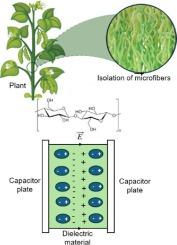Influence of Matrix, Filler, and structural design on the dielectric and energy storage properties of cellulose composites
IF 5.9
3区 工程技术
Q1 CHEMISTRY, MULTIDISCIPLINARY
Journal of Industrial and Engineering Chemistry
Pub Date : 2025-04-16
DOI:10.1016/j.jiec.2025.04.025
引用次数: 0
Abstract
Cellulose is a renewable, biodegradable, cost-effective, and easy-to-process natural biopolymer. Because of its dielectric, piezoelectric, and mechanical performance, cellulose and its composites are often used as a matrix, filler, substrate, gel electrolyte, and dielectric layer for flexible energy storage devices. They offer easy fabrication strategies and excellent mechanical properties. In this mini-review, we summarized the principles of dielectric and energy storage features of cellulose composites and factors affecting their dielectric properties, mainly exploring the incorporation of various filler materials in the cellulose matrices and cellulose materials acting as different types of fillers. Moreover, the fabrication strategies, structural design, and matrix-filler interactions of cellulose composites enhance their dielectric properties as systematically reviewed. This review summarizes the current state-of-the-art progress of cellulose dielectric composites, challenges, and future outlook for green dielectric and energy storage devices. The review suggests that optimizing the filler type, cellulose fiber content, fabrication techniques, and structural design can significantly enhance the dielectric properties and energy storage capacity of cellulose composites.

基质、填料和结构设计对纤维素复合材料介电和储能性能的影响
纤维素是一种可再生、可生物降解、具有成本效益且易于加工的天然生物聚合物。由于其介电、压电和机械性能,纤维素及其复合材料常被用作柔性储能装置的基质、填料、衬底、凝胶电解质和介电层。它们提供了简单的制造策略和优异的机械性能。本文综述了纤维素复合材料的介电原理、储能特性以及影响其介电性能的因素,重点探讨了纤维素基质中加入各种填料以及纤维素材料作为不同类型填料的情况。此外,纤维素复合材料的制备策略、结构设计和基质-填料相互作用增强了其介电性能。本文综述了纤维素介质复合材料的最新研究进展、绿色介质和储能器件面临的挑战及未来展望。研究表明,优化填料类型、纤维素纤维含量、制备工艺和结构设计可以显著提高纤维素复合材料的介电性能和储能能力。
本文章由计算机程序翻译,如有差异,请以英文原文为准。
求助全文
约1分钟内获得全文
求助全文
来源期刊
CiteScore
10.40
自引率
6.60%
发文量
639
审稿时长
29 days
期刊介绍:
Journal of Industrial and Engineering Chemistry is published monthly in English by the Korean Society of Industrial and Engineering Chemistry. JIEC brings together multidisciplinary interests in one journal and is to disseminate information on all aspects of research and development in industrial and engineering chemistry. Contributions in the form of research articles, short communications, notes and reviews are considered for publication. The editors welcome original contributions that have not been and are not to be published elsewhere. Instruction to authors and a manuscript submissions form are printed at the end of each issue. Bulk reprints of individual articles can be ordered. This publication is partially supported by Korea Research Foundation and the Korean Federation of Science and Technology Societies.

 求助内容:
求助内容: 应助结果提醒方式:
应助结果提醒方式:


